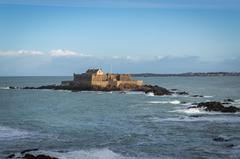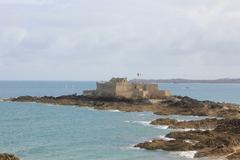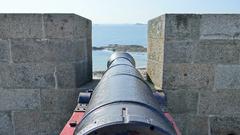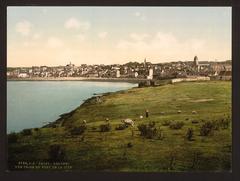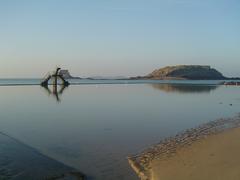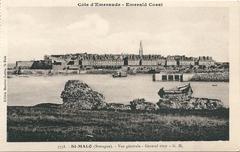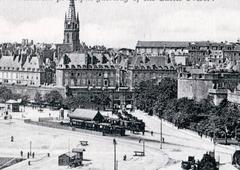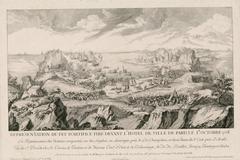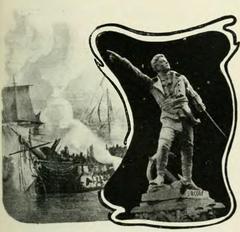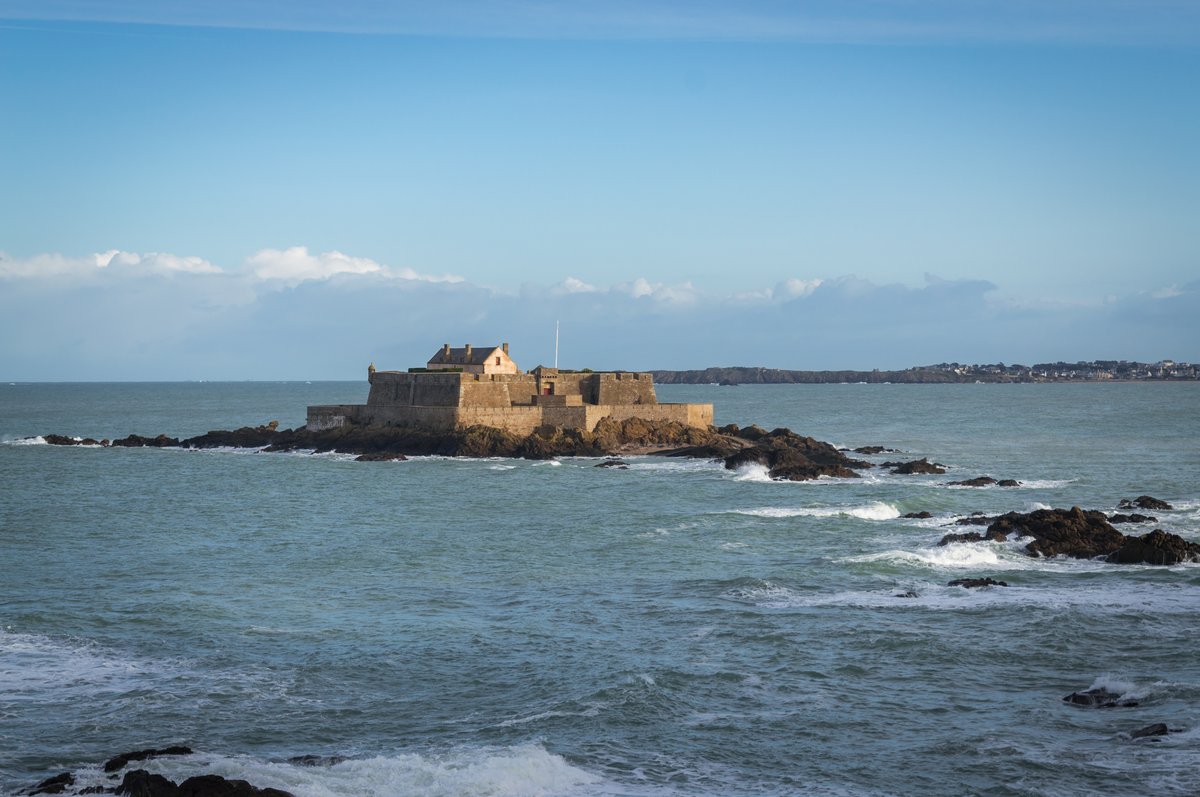
Visiting Fort National in Saint-Malo: Hours, Tickets, and Tips
Date: 23/07/2024
Introduction
Fort National, perched on a rocky islet just off the coast of Saint-Malo, France, is a testament to the country’s rich maritime and military heritage. Constructed in 1689 by Sébastien Le Prestre de Vauban, a renowned military engineer serving under King Louis XIV, Fort National was designed to fortify the French coastline against potential invasions. Its strategic location and robust architecture made it a formidable defensive outpost during significant historical conflicts, including the Nine Years’ War and the Napoleonic Wars (Saint-Malo Tourism). Fort National also played an essential role during World War II when it was occupied by German forces and later liberated by American troops (WWII History). Today, this historical monument stands as a symbol of Saint-Malo’s resilience and maritime legacy. Visitors can explore its well-preserved structures, enjoy panoramic views of the coastline, and delve into its storied past through guided tours and educational exhibits. This comprehensive guide will provide all the necessary information, from historical context to practical travel tips, to ensure a memorable visit to Fort National.
Table of Contents
- Introduction
- History of Fort National
- Visitor Information
- Architectural Features
- Cultural Significance
- Visitor Experience
- Preservation Efforts
- FAQ Section
- Conclusion
History of Fort National
Origins and Construction
Fort National, originally known as Fort Royal, was constructed in 1689 under the direction of the renowned French military engineer Sébastien Le Prestre de Vauban. Vauban, who served under King Louis XIV, was tasked with fortifying the French coastline against potential invasions. The fort was strategically built on a rocky islet just off the coast of Saint-Malo, a location chosen for its defensive advantages. The construction of Fort National was part of a broader initiative to enhance the coastal defenses of France, which included the construction of numerous other fortifications along the French coast (Saint-Malo Tourism).
Role in the Nine Years’ War
Fort National played a significant role during the Nine Years’ War (1688-1697), also known as the War of the Grand Alliance. This conflict saw France pitted against a coalition of European powers, including England, the Dutch Republic, and the Holy Roman Empire. The fort’s strategic location allowed it to serve as a critical defensive outpost, protecting the port of Saint-Malo from naval attacks. The fort’s cannons and garrison were instrumental in repelling several attempted invasions, demonstrating its effectiveness as a coastal defense structure (History of Saint-Malo).
The Fort in the 18th Century
Throughout the 18th century, Fort National continued to serve as a key defensive structure for Saint-Malo. During the War of the Spanish Succession (1701-1714) and the War of the Austrian Succession (1740-1748), the fort was maintained and upgraded to ensure its readiness for potential conflicts. The fort’s garrison was regularly rotated, and its armaments were kept in good condition. The fort also served as a deterrent against piracy, which was a significant threat to maritime trade during this period (French Fortifications).
The French Revolution and Napoleonic Wars
The French Revolution (1789-1799) and the subsequent Napoleonic Wars (1803-1815) brought significant changes to Fort National. During the Revolution, the fort was briefly occupied by revolutionary forces, who used it as a prison for political prisoners. However, its primary role as a coastal defense structure remained unchanged. During the Napoleonic Wars, the fort was once again fortified and garrisoned to protect against potential British naval attacks. The fort’s strategic importance was underscored by its continued use and maintenance during this tumultuous period (Napoleonic Wars History).
19th Century Decline and Restoration
Following the defeat of Napoleon in 1815, Fort National’s military significance began to wane. The fort was gradually decommissioned, and its garrison was reduced. By the mid-19th century, the fort had fallen into a state of disrepair. However, the fort’s historical significance was recognized, and efforts were made to preserve it. In the late 19th century, the fort was restored and opened to the public as a historical monument. This restoration effort was part of a broader movement to preserve France’s historical fortifications and promote them as tourist attractions (French Heritage).
World War II and Modern Era
During World War II, Fort National was once again thrust into the spotlight. The fort was occupied by German forces, who used it as part of the Atlantic Wall, a series of coastal defenses built by Nazi Germany to protect against Allied invasions. The fort was heavily fortified with additional bunkers and artillery. In August 1944, during the Battle of Saint-Malo, the fort was bombarded by Allied forces. Despite the damage, the fort remained structurally intact and was eventually liberated by American troops (WWII History).
In the post-war era, Fort National was restored and reopened to the public. Today, it stands as a testament to the rich history of Saint-Malo and serves as a popular tourist attraction. Visitors can explore the fort’s well-preserved structures, learn about its historical significance, and enjoy panoramic views of the surrounding coastline. The fort is accessible during low tide, allowing visitors to walk across the causeway and experience this historical landmark up close (Saint-Malo Fort National).
Visitor Information
Visiting Hours and Tickets
Fort National is open to visitors during low tide. It is crucial to check the tide schedules before planning your visit to ensure safe access across the causeway. The fort is generally open from [insert hours], and tickets can be purchased on-site or online. Ticket prices are [insert prices], with discounts available for children, students, and seniors.
Travel Tips
To make the most of your visit to Fort National, consider these travel tips:
- Wear comfortable shoes suitable for walking on rocky terrain.
- Bring a camera to capture the stunning views of Saint-Malo’s coastline.
- Check the weather forecast, as the fort is best visited on clear days.
Architectural Features
Fort National is characterized by its robust and functional design, typical of Vauban’s fortifications. The fort’s walls are constructed from granite, a material chosen for its durability and resistance to erosion. The fort’s layout includes a central courtyard, barracks, and gun emplacements. The fort’s strategic position on a rocky islet provides natural defensive advantages, making it difficult for enemy forces to approach undetected. The fort’s design reflects Vauban’s principles of fortification, which emphasized the use of geometric shapes and strategic positioning to maximize defensive capabilities (Vauban’s Fortifications).
Cultural Significance
Fort National is not only a historical monument but also a symbol of Saint-Malo’s resilience and maritime heritage. The fort has been featured in various cultural works, including literature and film, highlighting its iconic status. The fort’s history is intertwined with the history of Saint-Malo, a city known for its seafaring traditions and its role as a hub of maritime trade and exploration. The fort’s preservation and continued use as a tourist attraction underscore its enduring cultural significance (Cultural Heritage of Saint-Malo).
Visitor Experience
Today, Fort National is a popular destination for tourists visiting Saint-Malo. The fort offers guided tours that provide insights into its history and architectural features. Visitors can explore the fort’s various rooms and structures, including the barracks, gun emplacements, and the central courtyard. The fort also offers stunning views of the surrounding coastline and the city of Saint-Malo. The fort is accessible during low tide, and visitors are advised to check tide schedules before planning their visit to ensure safe access (Visit Fort National).
Preservation Efforts
Efforts to preserve Fort National are ongoing, with various initiatives aimed at maintaining the fort’s structural integrity and historical authenticity. These efforts include regular maintenance, restoration projects, and archaeological research. The fort is managed by local heritage organizations, which work to ensure that this historical landmark remains accessible to future generations. The preservation of Fort National is part of a broader effort to protect and promote France’s rich cultural and historical heritage (Preservation of French Forts).
FAQ Section
What are the visiting hours for Fort National? Fort National is open during low tide. It is essential to check the tide schedules before planning your visit to ensure safe access across the causeway. Generally, the fort is open from [insert hours].
How much do tickets to Fort National cost? Ticket prices for Fort National are [insert prices]. Discounts are available for children, students, and seniors.
Are there guided tours available? Yes, guided tours are available and provide valuable insights into the fort’s history and architectural features.
What should I bring for my visit? Wear comfortable shoes suitable for walking on rocky terrain, bring a camera for stunning views, and check the weather forecast for the best experience.
Conclusion
A visit to Fort National offers a unique opportunity to step back in time and experience the rich military and maritime history of Saint-Malo. From its construction in 1689 by Vauban to its pivotal roles in various historical conflicts, the fort has witnessed and withstood the test of time. Today, it serves not only as a historical monument but also as a symbol of the resilience and heritage of Saint-Malo. The panoramic views, architectural features, and educational tours make it a must-visit destination for history enthusiasts, architecture aficionados, and anyone looking to explore the cultural treasures of France. As you plan your visit, remember to check the tide schedules and weather conditions to ensure a safe and enjoyable experience. Fort National’s enduring legacy, combined with ongoing preservation efforts, ensures that this historical gem will continue to captivate visitors for generations to come. For more information and updates, don’t forget to download our mobile app Audiala.
References
- Saint-Malo Tourism. (n.d.). Saint-Malo Tourism
- History of Saint-Malo. (n.d.). History of Saint-Malo
- French Fortifications. (n.d.). French Fortifications
- Napoleonic Wars History. (n.d.). Napoleonic Wars History
- French Heritage. (n.d.). French Heritage
- WWII History. (n.d.). WWII History
- Saint-Malo Fort National. (n.d.). Saint-Malo Fort National
- Vauban’s Fortifications. (n.d.). Vauban’s Fortifications
- Cultural Heritage of Saint-Malo. (n.d.). Cultural Heritage of Saint-Malo
- Visit Fort National. (n.d.). Visit Fort National
- Preservation of French Forts. (n.d.). Preservation of French Forts
- UNESCO World Heritage. (n.d.). UNESCO World Heritage
